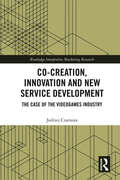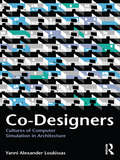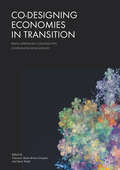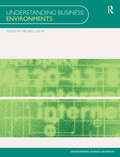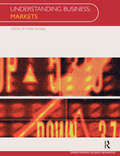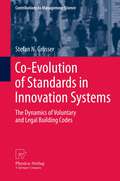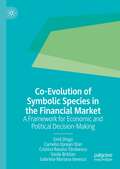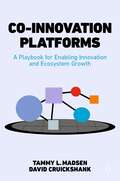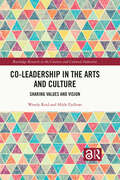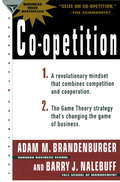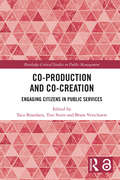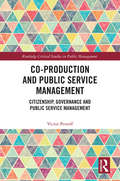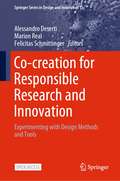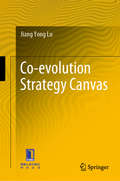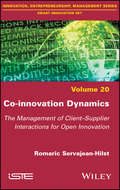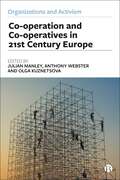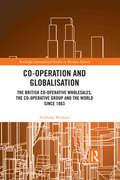- Table View
- List View
Co-Creation in der Creator Economy: So können Content Creators ihre Community an ihre Inhalte binden (essentials)
by Markus H. Dahm Johannes HeydenreichDieses essential wirft einen Blick auf die zunehmende Bedeutung von gemeinschaftlicher Kreation in der aufstrebenden Creator Economy und gibt Content-Erstellern wertvolle Einblicke und konkrete Ratschläge, wie sie durch die Zusammenarbeit mit Fans und Followern nicht nur die Arbeitslast teilen, sondern auch eine unterstützende Gemeinschaft aufbauen können. Das Buch analysiert erfolgreiche Co-Creation-Modelle, bei denen Content-Verfasser Inhalte gemeinsam entwickeln und dabei von gemeinsamen Vermarktungsstrategien und Monetarisierungsansätzen profitieren.
Co-Creation, Innovation and New Service Development: The Case of Videogames Industry (Routledge Interpretive Marketing Research)
by Jedrzej CzarnotaInvolving customers in the development and production of new services becomes a powerful force across many creative industries. Customers can directly supply the firm with innovative ideas, provide skilled labour, and act as a powerful force in marketing. Firms across the world, as they seek to innovate and to better respond to market needs, begin to recognize the benefits stemming from customers’ involvement in their operations. Co-creation also becomes more prevalent as customers begin to expect it from firms – seeking to influence their favourite services or products, and to have them better tailored to their needs. Nevertheless, empowering the customers and involving them in the internal affairs of a firm is both difficult and risky. Despite co-creation becoming increasingly important to firms, very few accounts of it exist and many firms fail. Therefore, to navigate those straits, and to reap the benefits of co-creation, requires knowledge and more complete understanding of socio-cultural forces underpinning it. By studying a wide array of videogames firms in the USA and Europe, this book provides a unique insight into co-creation. It builds on the existing theories to provide unified framework for understanding co-creation in creative industries and other sectors. It combines insights from the dynamics of customer communities, with firm’s perspective on innovation management and organizational transformation. The book offers highly detailed insights into the industry, which is at the forefront of co-creation. Furthermore, it sheds new light on the videogames firms and their operations and is therefore ideally designed for researchers, educators, and students alike in the fields of knowledge management, innovation management, firm strategy, organization studies and creativity management.
Co-Creation: Reshaping Business and Society in the Era of Bottom-up Economics (Management for Professionals)
by Jens P. Wulfsberg Tobias Redlich Manuel MoritzAcross several industries, we are observing a paradigm shift from traditional, firm-centric and top-down value creation to more open and collaborative approaches, also referred to as bottom-up economics. The boundaries of firms dissolve and external actors (customers, user, suppliers etc.) enter the domain of value creation by means of advanced information and communication technologies. These new and evolving patterns require a renewed and interdisciplinary understanding of how co-creation enables organizations to reshape business and society. With contributions from industrial and academic experts, this book provides deep insights into the theory and practice of bottom-up economics, and addresses the major opportunities and challenges that have emerged in the era of co-creation. A must read for decision-makers looking to innovate their companies' business models—from ideation to marketing. Dr.-Ing. Michaela Colla, K-GXI Leader – Industry 4.0 at Volkswagen Simply put, co-creation is the future of work. With technology morphing the way we work and young people wanting to tackle problems that matter, co-creation is the sandbox where the world can come together to solve big challenges. Plus, co-creation rapidly delivers products with built-in market fit. Megan Brewster, Vice President of Advanced Manufacturing at Launch Forth Successful leaders will co-create the future. This book is an excellent starting point.Jürgen Bilo, Managing Director co-pace GmbH, The Startup Organisation of Continental AG
Co-Designers: Cultures of Computer Simulation in Architecture
by Yanni LoukissasDesigners employ a variety of tools and techniques for speculating about buildings before they are built. In their simplest form, these are personal thought experiments. However, embracing advanced computer simulations means engaging a network of specialized people and powerful machines. In this book, Yanni Alexander Loukissas demonstrates that new tools have profound implications for the social distribution of design work; computer simulations are technologies for collective imagination. Organized around the accounts of professional designers engaged in a high-stakes competition to redefine their work for the technological moment, this book explores the emerging cultures of computer simulation in architecture. Not only architects, but acousticians, fire safety engineers, and sustainability experts see themselves as co-designers in architecture, engaging new technologies for simulation in an evolving search for the roles and relationships that can bring them both professional acceptance and greater control over design. By illustrating how practices of simulation inform the social relationships and professional distinctions that define contemporary architecture, the book examines the cultural transformations taking place in design practice today.
Co-Designing Economies in Transition: Radical Approaches in Dialogue with Contemplative Social Sciences
by Vincenzo Mario Bruno Giorgino Zack WalshThis transdisciplinary volume puts forward proposals for wiser, socially just and sustainable socio-economic systems in transition. There is growing support for the view that the end of capitalism is around the corner, but on which conceptual and ethical basis can we interpret these times? With investigations into feminist economics, post-growth environmentalism, socio-technical digital design, collaborative and commons economics, the editors create a dialogue between radical knowledge/practices and contemplative social sciences to transgress disciplinary boundaries and implement new visions of reality. This important book challenges our ways of thinking and outlines a pathway for new research. Chapter 13 of this book is available open access under a CC BY 4. 0 license at link. springer. com
Co-Economy: Netzwerke und agile Organisationsstrukturen erfolgreich nutzen
by Claudia Pelzer Nora BurgardWie können und müssen Unternehmen die digitale Vernetzung für sich nutzen? Welchen Mehrwert bieten dabei Crowd-basierte Lösungen und kollaborative Innovationen? Antworten auf diese grundlegenden Fragen liefert dieses Buch. Die Autorinnen erklären, wieso und in welcher Form auch die bestehenden Business-Modelle, Arbeits- und Organisationsformen einem Wandel unterliegen. Sie erläutern fundiert und leicht verständlich, welche Tools die Netzwerk-Ökonomie hervorgebracht hat, welche Auswirkungen sie auf einzelne Branchen hat und wie die Umsetzung in die Praxis funktioniert. Zahlreiche Beispiele zeigen, wie schnell Veränderungen, Branchen-Innovationen und -Disruptionen unterschätzt werden und wie wichtig Offenheit und Agilität für Unternehmen sind - heute mehr denn je.
Co-Ed Understanding Business Environments (Understanding Business Ser.)
by Vivek SunejaFirst published in 2002. Routledge is an imprint of Taylor and Francis, an informa company.
Co-Ed Understanding Business Markets: A Multidimensional Approach To The Market Economy (Understanding Business Ser.)
by Vivek SunejaFirst published in 2002. Routledge is an imprint of Taylor and Francis, an informa company.
Co-Evolution of Standards in Innovation Systems: The Dynamics of Voluntary and Legal Building Codes (Contributions to Management Science)
by Stefan N. GrösserMitigating climate change is one of the most profound challenges facing humankind. In industrialized countries, the residential housing sector produces roughly one-fourth of the greenhouse gas emissions. One solution to reduce these emissions is the availability of building codes that require high levels of energy efficiency. Given the current scientific knowledge, more research is needed to gain a proper systemic understanding of the underlying socio-economic and technical system. Such an understanding is crucial for developing high energy-efficiency standards because this system develops gradually over time and cannot be changed swiftly. This book creates a feedback-rich simulation model for analyzing the effects of different administrative policies on energy demand, the improvement of energy efficiency by means of building codes, and reductions in the greenhouse gas emissions. The dynamic model can contribute substantially to the discourse on energy policies and guide effective administrative interventions. The book will be a valuable resource for officials in the public energy administration, as well as researchers in the areas of innovation, diffusion processes, co-evolution, standardization, and simulation modelling.
Co-Evolution of Symbolic Species in the Financial Market: A Framework for Economic and Political Decision-Making
by Emil Dinga Camelia Oprean-Stan Vasile Brătian Gabriela-Mariana Ionescu Cristina Roxana TănăsescuThis book offers a systemic understanding of the evolutionary model of financial markets and their place with broader political economic systems. Through examining the co-evolutionary process, where the interplay between financial markets and society is highlighted, insight is provided into the concepts of growth, development, preference, information, and price. After outlining these core concepts, they are applied to co-evolution within financial markets to illustrate the mechanics that underpin economic systems. Binomial and trinomial co-evolution is then discussed in relation to financial market variables, preference and price in terms of symbolic utility, and logical economic modelling structures.This book presents a new research methodology based on a logical to approach economics that looks beyond historical and empirical economic frameworks. It will be relevant to students, researchers, and policymakers interested in financial economics.
Co-Innovation Platforms: A Playbook for Enabling Innovation and Ecosystem Growth
by Tammy L. Madsen David CruickshankStrategies and practices for growing ecosystems are increasingly important in shaping industries and markets. Sustaining productive innovation is not just about you. It depends on others as well as your willingness and ability to collaborate effectively. This book is about how to use, as well as develop, a co-innovation platform to accelerate innovation and sustain ecosystem growth. It will show how you, your team and your organization can create and foster collaborative innovation among a diverse set of organizations that are located outside of your company’s hierarchy. A co-innovation platform provides an environment where firms can combine or recombine ideas to generate novel solutions. A distinctive feature of the co-innovation platform is its resource-open and hands-on approach to innovation. For many organizations, resource limitations, organizational obstacles and/or time constraints kill an idea before it takes shape. By providing access to demand-side and supply-side resources and capabilities to facilitate co-innovation, the platform solves this problem and shapes the ecosystem’s innovation trajectory from the ground up. This book provides strategic and practical guidance for orchestrating collaborative problem solving and ecosystem growth.
Co-Intelligence: Living and Working With AI
by Ethan MollickFrom Wharton professor and author of the popular One Useful Thing Substack newsletter Ethan Mollick comes the definitive playbook for working, learning, and living in the new age of AI <p><p> Something new entered our world in November 2022 — the first general purpose AI that could pass for a human and do the kinds of creative, innovative work that only humans could do previously. Wharton professor Ethan Mollick immediately understood what ChatGPT meant: after millions of years on our own, humans had developed a kind of co-intelligence that could augment, or even replace, human thinking. Through his writing, speaking, and teaching, Mollick has become one of the most prominent and provocative explainers of AI, focusing on the practical aspects of how these new tools for thought can transform our world. <p><p> In Co-Intelligence, Mollick urges us to engage with AI as co-worker, co-teacher, and coach. He assesses its profound impact on business and education, using dozens of real-time examples of AI in action. Co-Intelligence shows what it means to think and work together with smart machines, and why it’s imperative that we master that skill. <p><p> Mollick challenges us to utilize AI’s enormous power without losing our identity, to learn from it without being misled, and to harness its gifts to create a better human future. Wide ranging, hugely thought-provoking, optimistic, and lucid, Co-Intelligence reveals the promise and power of this new era. <p> <b>New York Times Bestseller</b>
Co-Leadership in the Arts and Culture: Sharing Values and Vision (Routledge Research in the Creative and Cultural Industries)
by Wendy Reid Hilde FjellværThis book is about co-leadership: a leadership practice and structure often found in arts organizations that consists of two or three executives who bridge the art and business divide at the top. Many practitioners recognize this phenomenon but the research on this topic is limited and dispersed. This book assembles a coherent overview and presents new insights of the field. While co-leadership is well institutionalized in the West, it is also criticized for management’s constraint of artistic autonomy and for its pluralism that dilutes leadership clarity. However, co-leadership also personifies the strategic objectives of art, audiences, organization, and community, by addressing plural logics - navigating the demands of artistic vision and organizational stability. It is an integrating solution. The authors investigate its specifics in the arts, including global practice and its interdisciplinary nature. The theoretical frame of plural leadership supports their empirical explorations of the dynamics within the co-leadership relationship and with organizational stakeholders. Data includes the voices of co-leaders, artists, staff, and board members from arts organizations in Canada and Norway. Their abductive reflection generates a stimulating research experience. By viewing co-leadership in action, not as a study of static theories, the book will appeal not only to students and researchers but also resonate with practitioners in arts and cultural management and assist them to work with co-leadership and to manage its tensions.
Co-Leadership in the Arts and Culture: Sharing Values and Vision (Routledge Research in the Creative and Cultural Industries)
by Wendy Reid Hilde FjellværThis book is about co-leadership: A leadership practice and structure often found in arts organizations that consist of two or three executives who bridge the art and business divide at the top.Many practitioners recognize this phenomenon but the research on this topic is limited and dispersed. This book assembles a coherent overview and presents new insights of the field. While co-leadership is well institutionalized in the West, it is also criticized for management’s constraint of artistic autonomy and for its pluralism that dilutes leadership clarity. However, co-leadership also personifies the strategic objectives of art, audiences, organization, and community, by addressing plural logics – navigating the demands of artistic vision and organizational stability. It is an integrating solution. The authors investigate its specifics in the arts, including global practice and its interdisciplinary nature. The theoretical frame of plural leadership supports their empirical explorations of the dynamics within the co-leadership relationship and with organizational stakeholders. Data includes the voices of co-leaders, artists, staff, and board members from arts organizations in Canada and Norway. Their abductive reflection generates a stimulating research experience.By viewing co-leadership in action, not as a study of static theories, the book will appeal not only to students and researchers but also resonate with practitioners in arts and cultural management and assist them to work with co-leadership and to manage its tensions.Chapters 1 and 4 of this book are freely available as downloadable Open Access PDFs at http://www.taylorfrancis.com under a Creative Commons Attribution-Non Commercial-No Derivatives (CC-BY-NC-ND) 4.0 license.
Co-Opetition: The Game Theory That's Changing The Game Of Business
by Adam M. Brandenburger Barry J. NalebuffNow available in paperback, with an all new Reader's guide, The New York Times and Business Week bestseller Co-opetition revolutionized the game of business. With over 40,000 copies sold and now in its 9th printing, Co-opetition is a business strategy that goes beyond the old rules of competition and cooperation to combine the advantages of both. Co-opetition is a pioneering, high profit means of leveraging business relationships.Intel, Nintendo, American Express, NutraSweet, American Airlines, and dozens of other companies have been using the strategies of co-opetition to change the game of business to their benefit. Formulating strategies based on game theory, authors Brandenburger and Nalebuff created a book that's insightful and instructive for managers eager to move their companies into a new mind set.From the Trade Paperback edition.
Co-Ordination in Context: Institutional Choices to Promote Exports (Routledge Revivals)
by G.P.E. WalzenbachFirst published in 1998. This book makes an original contribution to our understanding of policy failures at the European and international level. On the basis of a comparative analysis the study shows how the co-ordination mechanisms available in the European Community and OECD have complicated the regulation of national policies on state aid to exporting industries. This failure can be explained in theoretical terms: international and supranational organisations are not neutral arbiters, but have interests of their own, interests which are not necessarily aligned with those of their member states. In detailed case studies of Britain, France and Germany the book examines how the preference structure of governments in the exercise of their promotion programmes contrasts with the policies enacted by international bureaucracies. Walzenbach’s interdisciplinary approach specifies the conditions under which policy co-ordination can have detrimental effects and thus, usefully corrects the benign view held by most regime theorists about transaction-cost reducing and efficiency enhancing role of such arrangement.
Co-Production and Co-Creation: Engaging Citizens in Public Services (Routledge Critical Studies in Public Management)
by Taco Brandsen Bram Verschuere Trui SteenCo-production and co-creation occur when citizens participate actively in delivering and designing the services they receive. It has come increasingly onto the agenda of policymakers, as interest in citizen participation has more generally soared. Expectations are high and it is regarded as a possible solution to the public sector’s decreased legitimacy and dwindling resources, by accessing more of society’s capacities. In addition, it is seen as part of a more general drive to reinvigorate voluntary participation and strengthen social cohesion in an increasingly fragmented and individualized society. "Co-Production and Co-Creation: Engaging Citizens in Public Services" offers a systematic and comprehensive theoretical and empirical examination of the concepts of co-production and co-creation and their application in practice. It shows the latest state of knowledge on the topic and will be of interest both to students at an advanced level, academics and reflective practitioners. It addresses the topics with regard to co-production and co-creation and will be of interest to researchers, academics, policymakers, and students in the fields of public administration, business administration, economics, political science, public management, political science service management, sociology and voluntary sector studies.
Co-Production and Public Service Management: Citizenship, Governance and Public Services Management (Routledge Critical Studies in Public Management)
by Victor PestoffThis volume compiles a dozen essays, by one of the most prolific proponents of co-production as a solution for many of the challenges facing public services and democratic governance at the outset of the 21st Century. Co-production is considered a partnership between citizens and public service providers that is essential for meeting a growing number of social challenges, since neither the government nor citizens can solve them on their own. These challenges include, among other things, improving the efficiency and effectiveness of public services in times of financial strain; increasing the legitimacy of the public sector after decades of questioning its ability with the spread of New Public Management; promoting social integration and cultural pluralism in increasingly diverse societies when millions of refugees and immigrants are on the move; tackling the threat of burgeoning populism following the rise of anti-immigrant and anti-global parties in many countries in recent years; and finally, finding viable solutions for meeting the growing needs of aging populations in many parts of the world. This volume addresses issues related to the successful development and implementation of a policy shift toward greater citizen participation in the design and delivery of the services they depend on in their daily lives and greater citizen involvement in resolving these tenacious problems, facilitated by the active support of governments across the globe. Moreover, it explores participatory public service management that empowers the front-line staff providing public services. Together with users/citizens they can insure the democratic governance of public service provision.
Co-creation for Responsible Research and Innovation: Experimenting with Design Methods and Tools (Springer Series in Design and Innovation #15)
by Alessandro Deserti Marion Real Felicitas SchmittingerThis open access book summarizes research being pursued within the SISCODE (Society in Innovation and Science through CO-DEsign) project, funded by the EU under the H2020 programme, the goal of which is to set up an analytical, reflective and learning framework to explore the transformations in initiatives and policies emerging from the interaction between citizens and stakeholders. The book provides a critical analysis of the co-design processes activated in 10 co-creation labs addressing societal challenges across Europe. Each lab as a case study of real-life experimentation is described through its journey, starting from the purpose on the ground of the experimentation and the challenge addressed. Specific attention is then drawn on the role of policies and policy maker engagement. Finally, the experimentation is enquired in terms of its output, transformations triggered within the organization and the overall ecosystem, and its outcomes, opening the reasoning towards the lessons learnt and reflections that the entire co-creation journey brought.
Co-design and Social Innovation: Connections, Tensions and Opportunities (Routledge Studies in Social Enterprise & Social Innovation)
by Garth BrittonAlthough co-design has been practised in new service and product development for some years, it has only recently begun to appear in the burgeoning field of social innovation. It appears to be well-attuned to this new context, offering as it does an open-ended relational process to generate novel solutions to problems whose very definition seems to escape more conventional approaches. However, even less research attention has been paid to co-design than to social innovation. This book explores the potential of co-design as a social innovation process. It reviews the diverse theoretical and disciplinary foundations on which co-design is based. It proposes a framework for understanding co-design as a cohesive practice across the extremely broad scope of its potential applications. It explores appropriate approaches to governance and evaluation of co-design initiatives and outlines the key issues and limitations on its use. Although it is intended to provide a robust theoretical basis for researching co-design initiatives, it will also be of interest to anyone who is contemplating putting co-design into practice.
Co-evolution Strategy Canvas
by Jiang Yong LuThis book discusses the problem that why entrepreneurs don’t have clear strategies in different phrases and how to solve it. The author uses the tools of human resource from inside and outside aspects to analyze the problem. What’s more, the author also discusses the problems from 4 dimensions, such as users, organizations, products and markets. Use the co-evolution strategy canvas to summarize solutions for different phrases of enterprises.
Co-innovation Dynamics: The Management of Client-Supplier Interactions for Open Innovation
by Romaric Servajean-HilstOver the last 30 years, the pace of innovation has exploded while available resources have become increasingly scarce. Open Innovation is the solution, with client–supplier relationships being the main expedient. <P><P> However, collaborating in innovation is full of obstacles, from uncertainties in innovation as a whole to difficulties with managing a business relationship. <P><P> Co-innovation Dynamics, based on a deep-dive ethnographic inquiry enlightened by state-of-the-art management research, presents the daily life story of a collaborative innovation project. Also, based on two other qualitative and quantitative studies on co-innovation management, this book offers lessons and tips on how to manage the dynamics of collaborative innovation in the client–supplier relationship.
Co-operation and Co-operatives in 21st-Century Europe
by Julian Manley, Anthony Webster and Olga KuznetsovaThis volume explores where, how and why the cooperative model is having a distinctive, transformational impact in driving socio-economic changes in a post-pandemic 21st century world. Drawing from a diverse range of examples, the book sheds light on how today’s cooperatives and a co-operative way of organising might serve new societal demands. It examines organisational structures and governance models that develop socio-economic resilience in cooperatives. The book’s contributors reveal how the very pursuit of cooperative values and principles challenges market fundamentalism and promotes participatory democracy. This is a timely contribution to recent debates around transformative economies and an invaluable resource for scholars and activists interested in alternative ways of organising.
Co-operation and Development in the Energy Sector: The Arab Gulf States and Canada (Routledge Library Editions: Energy)
by Atif A. Kubursi Thomas NaylorOriginally published in 1985. This book gives the views of both oil producers and oil consumers, detailing in a systematic manner the problems that they have encountered in the energy field and the solutions that they have devised to deal with them. The book makes clear that producers and consumers have common purpose in the conservation and judicious management of the dwindling and non-renewable world oil resources. It also makes clear that they share a consistent vision of the industry’s future development. The contributions to the book explore a range of important themes in the development of the energy sector. The future of OPEC is discussed in the context of the state of the world oil market. Other chapters consider the lessons that have been drawn by the Arab Gulf oil producers and throughout the book there is comparison with the experience of Canada providing a number of important insights into the operation of the world oil industry.
Co-operation and Globalisation: The British Co-operative Wholesales, the Co-operative Group and the World since 1863 (Routledge International Studies in Business History)
by Anthony WebsterGlobalisation is associated with capitalist multinationals dedicated to the enrichment of wealthy, corporate shareholders. However, less well known is that the English and Scottish Co-operative Wholesale Societies, owned by the growing number of local co-operative societies across the country, were early leaders in global commerce. Owned by their working-class members, by 1900 there were over 1,000 societies and millions of individual members. Spreading profits widely through the ‘divi’ which rewarded members shopping at the co-op store, and selling safe and wholesome food, the co-operative movement was a successful part of the emerging labour movement. This success depended on the wholesale societies supplying societies with commodities from all over the world. Because local societies were free to source produce from whoever they chose, competitive pressures required the wholesale societies to develop the world’s most formidable network of international supply chains, with branches, depots, plantations and factories in the USA, Canada, Denmark, Sweden, Spain, Greece, France, Germany, India, Ceylon, Australia, New Zealand, colonial West Africa and Argentina. This book explains how the wholesales developed and managed these networks, giving them a competitive advantage in their dealings with the local societies. It will explore why and how this ‘People’s Global Colossus’ declined in the later 20th century, and how its focus in international commerce moved onto ethical sourcing, investment and Fair Trade. Integral to these global networks were the UK movement’s relations with foreign co-operative movements, especially through involvement in the International Co-operative Alliance, and promotion of co-operatives in the Empire by successive British governments as a tool for economic development. The ‘People’s Colossus’ was thus a political as well as a commercial player in the increasingly complex world of the late 19th and 20th centuries.

